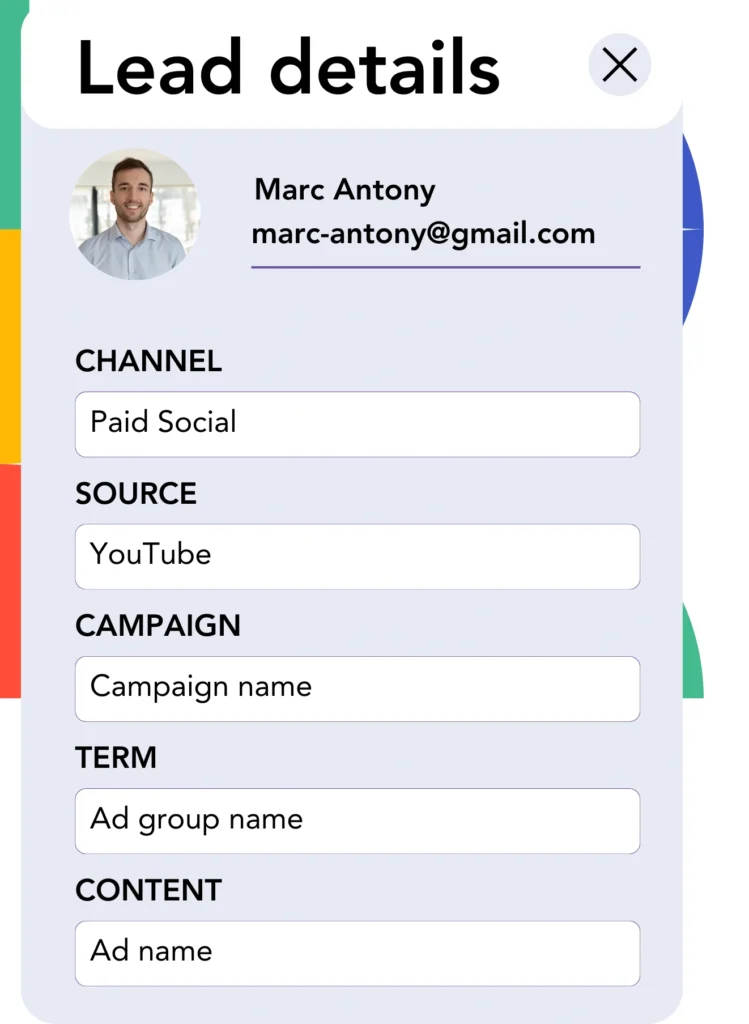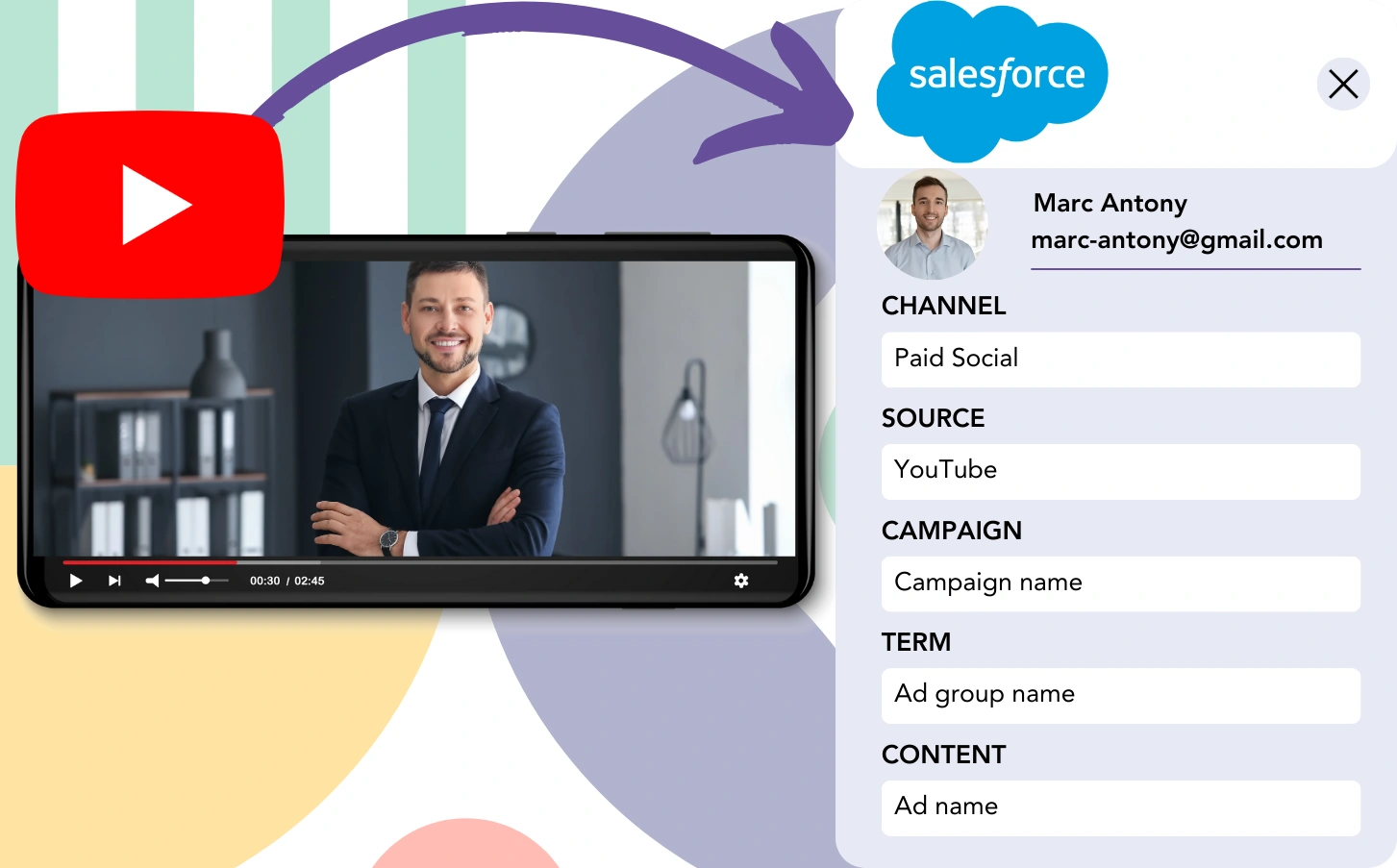You generate leads on YouTube and send them to Salesforce, but you can’t connect each lead to a specific YouTube ad. Likewise, when a lead becomes a customer, there’s no way to link that customer back to an exact YouTube ad.
This lack of tracking stops you from measuring your YouTube ads’ performance, making it hard to know which ads are actually bringing in leads and customers. As a result, you spend on many ads without really understanding their impact.
Luckily, there’s an easy way to link each lead to the specific YouTube campaign, ad group, and ad that generated it.
Let’s go through it step by step!
How to Track YouTube Ads in Salesforce
Step 1: Add Leadsources in the head tag of your website

Leadsources is a simple tool that tracks the source of your leads. Once added to your website, it tracks up to 7 lead source data for each lead you generate.
➡️ Sign up to Leadsources.io for free
➡️ Add the Leadsources tracking code to your site
Step 2: Add the UTM parameters to your YouTube Ads

In your ad URL, add UTM parameters to capture YouTube ad data, including campaign, ad group, and ad. You can use the following:
UTM_source=YouTubeUTM_campaign=campaign-nameUTM_term=ad-group-nameUTM_content=ad-name
The final URL should look like this:
https://www.yourdomain.com/?&UTM_source=youtube&UTM_campaign=campaign-name&UTM_term=ad-group-name&UTM_content=ad-nameNote: Leadsources captures lead source data—even without UTM parameters—ensuring comprehensive tracking for every lead.
Step 3: Add the hidden fields in your form

Hidden fields are form fields that are invisible to the user but can store information that gets submitted along with the form.
Leadsources saves lead source data in these hidden fields. When a lead submits the form, Leadsources automatically fills these fields with YouTube Ads data.
Step 4: Capture the YouTube Ads data in Salesforce

When users click your ads and land on your site, Leadsources fetches the YouTube campaign, ad group, ad data, and more.
Leadsources then fills this YouTube ad data into the hidden fields of your form.
When the form is submitted, you can view the YouTube ad data along with lead details in Salesforce (requires connecting your form to Salesforce).
How does Leadsources work?
Whenever someone lands on your site, Leadsources fetches YouTube ad data and populates it into the hidden fields of your form. Once the form is submitted, this data, along with lead information like name and email, is sent to Salesforce.
Leadsources tracks all this lead source data for each lead:
| Lead source data | Fetched automatically |
| Channel | ✅ |
| Source | ✅ |
| Campaign | ✅ OR use UTM_campaign |
| Content | UTM_content parameter is required |
| Term | UTM_term parameter is required |
| Landing page | ✅ |
| Landing page subfolder | ✅ |
As shown in the table above, when UTM parameters can’t be applied—such as with organic sources like Google search or a publication of your website in an article—Leadsources still captures the following lead source data:
- Channel
- Source
- Campaign
- Landing page
- Landing page subfolder
Unlike other tools, Leadsources tracks lead source across all marketing channels, both organic and paid.
Performance reports: Lead, sales, and revenue by source
By tracking YouTube Ads data in Salesforce, you can create performance reports such as:
- Leads, sales, and revenue by channel
- Leads, sales, and revenue by source
- Leads, sales, and revenue by campaign (aka. YouTube campaign)
- Leads, sales, and revenue by term (aka. YouTube ad group)
- Leads, sales, and revenue by content (aka. YouTube ad)
This helps you adjust your YouTube Ads budget based on the campaigns, ad groups, and ads that drive the most leads, sales, and revenue.
Let’s look at some of the reports you can generate!
1. Lead source reports
Create performance reports that display the number of leads generated by:
- Channel
- Source
- Campaign (aka. YouTube campaign)
- Term (aka. YouTube ad group)
- Content (aka. YouTube ad)
- Landing page
- Landing page subfolder
Example #1: Leads by channel
This report helps you determine which channel generates the most leads.

Example #2: Leads by YouTube campaign
Now you can focus on a specific lead source (e.g., YouTube) and track the number of leads generated by each YouTube campaign.

Example #3: Leads by YouTube ad
After identifying the YouTube campaign that drives the most leads, you can analyze which specific ad group or ad is generating those leads.

2. Sales and revenue source reports
Now that we know which YouTube campaign, ad group, and ad generate our leads, we need to determine if these leads are converting into sales and revenue.
To do this, connect your leads to a CRM like Salesforce. This lets you track sales and revenue generated by various channels, sources, YouTube campaigns, ad groups, ads, landing pages, and landing page subfolders.
With this data, you can refine your YouTube Ads strategy to focus on the channels, sources, campaigns, ad groups, and ads that bring in the highest sales and revenue.
You can generate a variety of sales and revenue reports, such as:
- Sales and revenue by channel
- Sales and revenue by source
- Sales and revenue by campaign
- Sales and revenue by term (e.g., YouTube ad group)
- Sales and revenue by content (e.g., YouTube ad)
- Sales and revenue by landing page
- Sales and revenue by landing page subfolder
Example Scenario:
| Channel | Search Paid | Social Paid |
|---|---|---|
| Leads | 50 | 75 |
| Sales | 5 | 6 |
| Average Order Value | $150 | $100 |
| Revenue | $750 | $600 |
After launching ads on Google and YouTube, the initial “Leads by Channel” report showed that Social Paid ads (YouTube) generated more leads than Search Paid ads (Google).
However, after analyzing sales and revenue data in Salesforce, you discovered that the Search Paid channel brought in higher revenue with fewer leads than the Social Paid channel. Based on this insight, you adjusted your budget to allocate more resources to the Search Paid channel.
LeadSources tracks the source of each lead in Salesforce, whether they come from ads, organic search, social, email, etc. and syncs that data with each submission. See the full breakdown on the lead source in Salesforce page.

